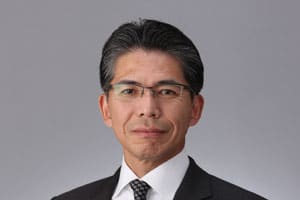 When Yoshihiko Hatanaka was appointed president and CEO of Astellas Pharma last June, the six-year-old company was already moving in a direction he had played a large role in setting. He was part of the merger preparation committee that oversaw the fruitful union of two of Japan’s oldest pharmaceutical companies, Fujisawa and Yamanouchi, in 2005.
When Yoshihiko Hatanaka was appointed president and CEO of Astellas Pharma last June, the six-year-old company was already moving in a direction he had played a large role in setting. He was part of the merger preparation committee that oversaw the fruitful union of two of Japan’s oldest pharmaceutical companies, Fujisawa and Yamanouchi, in 2005.
The following year, he was instrumental in starting VISION 2015, the company’s roadmap to 2015. Then, in 2010, he took the lead in developing the mid-term plan through to 2014. “So, although the leadership changed last June, I won’t be changing the direction of the current Astellas,” he says.
That means continuing to work towards global category leadership in areas with high unmet needs under the corporate ethos entitled ‘Changing Tomorrow’. In Astellas’ case, that means building on the strong positions it has already established in urology and transplantation and continuing to develop its presence in oncology.
Future areas for global category leadership include immunology and infectious disease, neuroscience, diabetes mellitus (DM) complications and metabolic diseases. Such a strategy, when coupled with stripping the business of anything not in the innovative pharmaceutical space – generics, over-the-counter products and diagnostics – puts the mid-sized company firmly at the high end of the medicines business.
| Biography Yoshihiko Hatanaka was born on April 20, 1957. He studied economics at Hitotsubashi University, Tokyo, Japan, graduating in 1980. In April of that year, he joined Fujisawa Pharmaceutical Co Ltd. In April 2003, he became director of the corporate planning department, followed in April 2005 by his appointment as director of the corporate planning department, corporate strategy division. He took the position of corporate executive and director of corporate planning department, corporate strategy division in June 2005. April 2006 saw him become corporate executive of the company and president and CEO of Astellas US LLC and president and CEO of Astellas Pharma US, Inc. He took the role of senior corporate executive of the company and president and CEO of Astellas US LLC and president and CEO of Astellas Pharma US, Inc. in June 2008. In April 2009, he was senior corporate executive of the company, corporate strategy technical officer and corporate finance officer (CSTO & CFO) and in June 2011 he took his current position as senior corporate executive of the company, president and CEO. |
The pure pharma player is a natural response to what many see as the hollowing out of the medicines business over the next few years, with generics companies at one end of the spectrum and innovative ones at the other, with very little in between. But aspiring to be a global category leader requires something extra. Hatanaka describes this as a combination of world-class knowledge and utilising close relationships with regulatory bodies and contacts with key external experts.
Precision medicine
“To take a leadership position, obviously innovation is key,” he says. “So, how can we increase our R&D productivity while also managing costs? These are questions every pharmaceutical company is asking. Our approach, as far as R&D is concerned, lies in precision medicine. In the past, a mass medicine approach worked well, but now we have to carefully categorise our position and identify sub-populations of patients that will benefit from our products in terms of better efficacy or less side effects.”
Astellas knows the old approach well, having licensed Lipitor from Pfizer in the Japanese market. According to the business intelligence database, EvaluatePharma, the company earned $1.37bn in 2010 from what was the world’s best-selling drug, but these revenues are expected to halve by 2016, now it is off patent, to $667m.
The choice of cancer as the third area for global category leadership was determined by the high level of unmet need in this area, but it is also a natural fit for a precision medicine approach. Indeed, the company’s first step towards developing a presence in oncology was its acquisition, in December 2007, of Agensys, a private US biotech firm that focuses on antibody technology. Three years later, the company acquired OSI Pharmaceuticals for $4bn, which brought with it not only a blockbuster drug in Tarceva and an experienced oncology sales force, but also, given its specialisation in small molecule discovery, research capabilities that complement those of Agensys.
The company also has various in-licensing deals in the oncology space, including one concluded last year worth $1.4bn with Aveo Pharmaceuticals for tivozanib, which is currently being tested in renal cell cancer among other indications. It acquired the European marketing rights to Eligard, a prostate cancer drug, from MediGene via this route and is co-developing a compound for acute myeloid leukaemia with Ambit.
Astellas now has 15 clinical development projects in oncology, the most advanced of which is MDV3100, a first-in-class androgen-receptor signalling inhibitor that recently produced positive phase III results from an interim analysis in men with advanced prostate cancer previously treated with chemotherapy.
R&D resources
Having sufficient resources to be a pure pharma player was one of the criteria for the merger of Yamanouchi and Fujisawa. “Our first objective was to be able to spend more than $1bn a year on R&D,” says Mr Hatanaka. “That was considered key to play within the pharmaceutical market.” According to EvaluatePharma, Astellas’s R&D spending stood at $2.5bn in 2010, around 20 per cent of its revenues.
The second objective was to expand the company’s reach across the globe. Both constituent parts were headquartered in Japan and had some presence in the Asian territories, but Yamanouchi was strong in Europe and Fujisawa in the US. Now, while 50 per cent of the sales of Japan’s second-largest pharma company still come from the domestic market, Europe and the US roughly share more than 40 per cent, with the rest of the world accounting for around five per cent. The third objective was to increase the talent pool. “Now, when I look back on these three objectives, I am happy because I believe we have achieved them all,” he says.
This ultra-clear management style filters through all the company’s operations. VISION 2015 highlighted three systems that would help fulfil its goal of global category leadership. One involves its more than 16,000-strong workforce within its ‘human resources management system’. “We realise that innovation comes from people, so talent is the most important thing for us to drive our business,” he says. To that end, he continues, it is “an important strategic objective” to be an employer of choice, something he claims has now been recognised in the US, Japan, Korea and several European countries where it has a presence.
But being a preferred place to work does not guarantee the talent required to be a global leader. So, in October 2011, Astellas launched the first cohort of a training programme – the Executive Leadership Series – to create top-tier personnel in Europe, US and Asia with the appropriate skill sets. In particular, Hatanaka states that that means thinking with a global mindset.
Having worked in the US and Europe for Fujisawa and headed the Astellas US operation from 2006 to 2009, he knows something about the profound cultural differences that can so easily hamper global business negotiations. As such, he tries to encourage his management team not to think of Tokyo as the centre of its universe, but to take a more detached, loftier perspective. “I want people to think cosmically,” he says. “I try to imagine that I am stationed in space looking down on the earth with no cultural divisions.”
Information sharing
“We try to share as much information as possible with our employees,” he says. “It is very important to get commitment from each of them and to share the same kind of direction and vision.” Underpinning that direction are the core values of Astellas, the primary one of which is that patient health always comes first. “Wherever I go and any opportunity I have, I stress that every job is related to patient health,” he continues. “This is a message not only for our medical representatives, the researchers or those in development work. Nor is it just for our external stakeholders. All supporting jobs at Astellas are also focused on patient health. Another important thing I want to mention is that we share this common value while at the same time respecting diversity. This is our philosophy and a good way of expressing how Astellas operates,” he adds.
It is a message that will have featured strongly during Mr Hatanaka’s recent trip to London when a number of so-called ‘town hall’ meetings with employees were scheduled, as well as a dinner with the managing directors of the major European affiliates. “Although we have several ways of communicating strategy globally, still face-to-face meetings are best,” he asserts.
The third system to realise global category leadership, Mr Hatanaka explains, is management based on corporate social responsibility (CSR) with integrity and compliance at its core. “To be a sustainable business, it is important to gain the trust or credibility of the community or our customers,” he goes on. “This is because it can take more than a decade to build up, but can be lost in a second.”
One way of building that trust is to offer company employees the opportunity to undertake voluntary projects that benefit their local community. In the seven months to October 2011, some 6,000 staff across the world had taken part in such projects that included teaching healthy eating to children, gardening, building and painting fences, and cleaning up areas of the community.
Such local endeavours make more sense when seen through the philosophy underpinning CSR-based management. The company describes this as ‘a programme through which we strive towards sustained enhancement of enterprise value while remaining acutely aware of our social responsibilities and taking a broad view that considers economics, society and humanity, so that we can exist not just as a market entity but also a meaningful member of society’.
Mr Hatanaka’s commitment to that noble goal is arguably best summed up in his clarity of vision regarding the company’s focus on innovation, on patients and on direct communication to the workforce, so everyone can speak with one voice.
Read our interview with president and CEO of Astellas Pharma Europe, Ken Jones.

The Interviewer
Jacky Law is a freelance writer specialising in the pharmaceutical industry.




